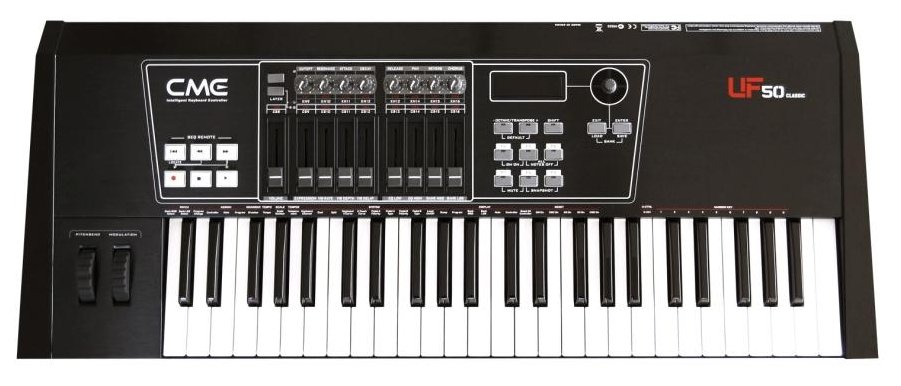Cme Uf Series Midi Keyboard Driver For Mac Os X

Somee.com avarage uptime is 99.994% (rank #888 on our directory) with total 86011 succesulf and 5 failed checks, monitored since 2006-01-25. Similar companies with 99.994% uptime are. Gotovie tablici excel. Search for 'somee.com' on 3 biggest search engines returns average of 225300 results so company name popularity rank is #37.
The UF60 provides a multitude of programmable controls, including nine sliders, eight knobs, and six function buttons, as well as transport controls. CME made its mark on the keyboard world with the introduction of the original UF series, a collection of four robust, feature-rich MIDI/USB keyboard controllers. Now comes the next generation of UF controllers, which offers improved functionality, expansion capability, comfortable action, and WIDI wireless MIDI technology. However, all is not well in UF-land — the documentation is woefully inadequate, leading to some serious confusion. First Impressions Just like the previous-generation UF series, the new models come in four flavors. The 49-key UF50 ($329.99), 61-key UF60 ($379.99), and 76-key UF70 ($469.99) have a semiweighted action, while the UF80 ($649.99) sports an 88-key, weighted hammer-action keyboard.
Like the other updated UF series MIDI controllers, the UF-80 has a built-in duplex. Music styles, as well as the U-CTRL music software auto-recognition system for. USB MIDI port, Power can be supplied via USB; Win2000/XP and Mac OS X. May 8, 2012 - I was thinking of getting another midi master Keyboard. Before that, there were no official drivers for win7 or vista 32 bit, so the community wrote them. Depending on the model range the quality can be pretty decent, particularly for the money. I use Mac and Win7 and they both work fine, no issues.
CME sent me a UF60 for this review, and I tested it with my 17-inch MacBook Pro running Image Line PoiZone, Propellerhead Reason, Ultimate Sound Bank PlugSound Pro, and Apple Logic Pro 7. The computer has a 2.16 GHz Intel processor with 2 GB of RAM and a 120 GB hard drive. Housed in a sturdy aluminum outer case, the UF60 is well suited for life on the road as well as in the studio. I was impressed with the unit's construction quality and logical layout, and the knobs, sliders, and switches seem like they'll hold up to lots of use. The transport controls remind me of the beefy switches you used to find on analog multitrack recorders. The pitch-bend and mod wheels also seem like they're built to last. In addition to a power switch and power-supply receptacle, the back panel has connections labeled MIDI Out, Pedal A, Pedal B, and USB.
The pedal jacks default to Sustain for Pedal A and Volume for Pedal B, but you can change the pedal type and polarity with a few simple keystrokes. Also included is an ⅛-inch Breath Control jack for use with a Yamaha BC3 breath controller. There aren't many keyboards on the market with breath-controller capability, so this is a welcome feature.

A removable panel hides the expansion bay, which can accommodate plug-in circuit boards that add various functions (more on this later). WIDI Works I was skeptical when I heard that the new UF controllers have built-in wireless MIDI capability, with an RF transmitter built into the keyboard and a receiver about the size of a thumb drive that plugs into the computer's USB port. Would it work? How much time would I waste trying to get it to work? To my delight, WIDI worked flawlessly. Setup was simple — I plugged in the receiver to my MacBook Pro, powered up the UF60 and computer, launched PlugSound Pro, and I was up and running — wirelessly.
According to CME, the WIDI system has a maximum operating range of 262 feet and high-speed error correction. I felt absolutely no latency when playing via WIDI; notes triggered as quickly as they would with a wired MIDI connection, which is to say virtually instantly. A Piece of the Action I learned to play on a weighted action, so I enjoy playing a keyboard that puts up a bit of a fight. Synth players will appreciate the tight, consistent feel of the UF60's action, and there's enough resistance to satisfy piano players as well. One of my first adjustments was selecting a Velocity curve. There are ten choices here, including three so-called Fixup curves that fix the Velocity value at 64, 100, or 127.
These might come in handy if you need to program many notes with the same Velocity. You can also tweak Aftertouch with seven preset curves. You'll want to experiment with the different presets to find the one that works best for your playing technique. Hands On Pair the UF60 with any soft synth, and you get that “real” hardware vibe thanks to eight knobs and nine sliders. These controls are labeled according to their default assignments, but they can be reassigned to any parameters.
In addition, the assignments can go three layers deep, providing access to more parameters than meet the eye and allowing you to tailor the controls to meet your specific needs. The UF60 provides a function called U-CTRL, which emulates the Mackie Control Universal (MCU) protocol. By enabling MCU in compatible programs such as Reason and Logic, the keyboard's transport and other buttons can be automatically mapped to control the corresponding functions in the software.